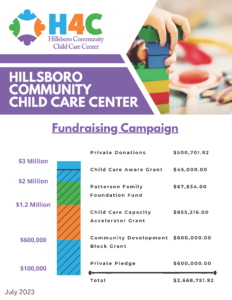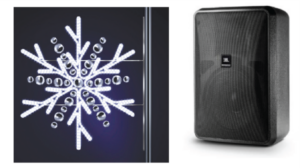Greetings from the community foundation!
As always, it is our pleasure to work with you as you fulfill your charitable intentions. Every day, we are inspired by the generosity of our donors and fund holders. We’re thrilled that the word is spreading, too! Many fund holders have introduced us recently to colleagues and friends, and we are grateful for these referrals. If you have not yet established your donor-advised or other type of fund at the community foundation, we look forward to working together to explore the best options for you and your family.
In this issue, we’re covering topics that surface quite frequently in our conversations with fund holders, donors, and friends in the community.
–Even philanthropy has a learning curve, both for adults and especially for children. If you are interested in teaching your children–especially your young children–about what charitable giving is all about, consider leaning into positive reinforcement. A child can learn a lot when they understand that the simple actions they take every day–whether it’s tossing coins into a fountain to support a children’s hospital or donating their gently-used clothing–make a difference in the lives of others. Young children enjoy talking about the things they care about, and a dialogue with a parent or grandparent can really help ignite their charitable spirit. The community foundation is always happy to offer ideas and opportunities to get the whole family involved in the joy of giving.
–If you’re an entrepreneur like many of the donors and fund holders at the community foundation, you may have noticed a few parallels between how you approach charitable giving and how you approach growing your business. You may also see similarities between growing a business and the issues faced by the nonprofit organizations you support. This is not an accident! Indeed, when it comes to philanthropy, entrepreneurs tend to “give like they made it,” treating their support of favorite causes as an investment in the community they love.
–August may be National Make-a-Will month, but really anytime of year is a good time to review your estate plan and make sure that you’ve captured your wishes for gifts to family and loved ones, as well as gifts to the charities you’ve supported throughout your lifetime. The community foundation offers tax-savvy, easy ways to help you and your advisors incorporate charitable wishes into your estate plan, including the ability to update your intentions for charitable gifts over the years to reflect current involvement in favorite causes.
Thank you for being part of the community foundation, and thank you for all you do for our region through charitable giving! We appreciate the opportunity to work together.
Angie Tatro, CEO
 Making it fun: Tips for teaching children about philanthropy
Making it fun: Tips for teaching children about philanthropy
Over the years, you’ve probably taught your young children, grandchildren, nieces, and nephews lessons along the lines of “share and share alike” and “better to give than to receive.” But how do you transition these lessons into more concrete instruction about charitable giving, without risking the youngest members of your family becoming overwhelmed or bored? And how can you make those lessons effective as children grow older?
To inspire teenagers and young adults, consider tapping into an increasingly popular topic among younger generations, which is the notion of “purpose.” “Finding one’s purpose,” in the context of both personal lives and careers, is also a concept that can unite generations within a single family. The overarching purpose of giving can be framed as making the world a better place or strengthening the community. This translates nicely for youths who are seemingly always asking, ”Why?”
Teaching young children about philanthropy can be a little tricker. Indeed, many donors and fund holders at the community foundation have expressed an interest in learning how to do this. Here are a few principles that might help. And, as always, reach out to the team at the community foundation for ideas related to your own particular situation.
Positive reinforcement is a must.
As with any successful learning experience, positive reinforcement is a must in teaching the values of charitable giving. In particular, you may want to consider reinforcing that every charitable gift is good regardless of the profile of the giver, the size of the gift, or the nature of the recipient. Positive reinforcement in charitable giving is effective because it first engages the charitable giver’s own understanding of what it means to be philanthropic—from the giver’s own perspective–even if that giver is very young. So when your school-age children or grandchildren are raising money for a charity through a school fundraiser, throwing coins into a fountain to support a local children’s hospital, or donating gently-used toys and clothing, make sure you let the child know that these gifts really do make a difference.
Charitable giving can be defined expansively and inclusively.
When you’re talking with a 10-year-old, conversations about giving back are most productive when they go well beyond discussions about big checks written to highly-visible organizations. You may find it helpful in your conversations to cast a wide net around the definition of what it means to be charitable, often including things like adopting an older dog who needs a home, turning off lights to help the environment, cooking dinner for neighbors in need, helping to pay a family member’s medical bills, and recycling aluminum cans. Your enthusiasm during the conversation will be contagious as you convey the opportunities. The world is full of good deeds waiting to be done!
Tap into what the child cares about.
How do you know what charitable causes might inspire the young children in your life? Ask! You’re likely to hear things like animals, moms, friends, family, trees, school, reading and writing, having a home, finding missing people, helping to rescue victims of natural disasters, and having clean air and water. Any one of these elements gives you a fantastic opening for further dialogue, especially when you start that conversation based on the lens through which children see the world in their everyday lives and identify the needs within it. Charitable giving opportunities are abundant!
Understand that children have a power and direction all of their own.
Even 10-year-olds these days are assertive, aware of news and world affairs, and most importantly, digital natives. They like to figure things out on their own. With the tiniest bit of guidance and a lot of encouragement, their ideas go a long way. Let a child’s interests guide your lesson on giving. You do, however, have a strong power of suggestion as an adult. Kids do not necessarily know how to find the exact names of charitable entities, and they certainly do not know what “501(c)(3)” means, but they remember a place after they’re told it does lots of good for people.
Keep it short and keep it mutual.
The children in your life are brilliant, wonderful, and perceptive, but they do have short attention spans. Make the lessons informal, spontaneous, and flexible, and create plenty of opportunities for storytelling and game time. Children have a story for everything, and they love to share. Let them talk about how they feel. Let them tell you how, where, and why they want to give.
Take action!
Finally, don’t just talk–take action! For children with a grasp of money, charitable values can be taught through allocations. For the youngest, that may be from a weekly allowance or earnings from performing household chores. For the more experienced, allotments can come from after-school or summer job earnings. Giving can be highly interactive or participatory. For example, parents can show children the causes they support or suggest potential grantees based on the child’s interests, and let them choose. Parents can also show them how a gift can be easily made from the family’s donor-advised fund at the community foundation, which offers many benefits and can often be named to include names of the child or children.
At the community foundation, we’re here to help your family–even its youngest members–convert ideas into reality for the causes they care about the most.
 Like entrepreneurs, philanthropists inspire and innovate through their investments
Like entrepreneurs, philanthropists inspire and innovate through their investments
Despite the recently-announced decline in 2022 charitable giving, we continue to hear inspiring stories from you and other fund holders and donors. We’re also hearing from more and more individuals and families who are not yet fund holders that they’re very interested in establishing a donor-advised, field-of-interest, designated, or unrestricted fund at the community foundation, and nothing could make us happier! Increasing charitable giving and connecting donors to their favorite important causes are our priorities at the community foundation.
The uptick in conversations about philanthropy has inspired us to reflect on the noteworthy generosity of so many entrepreneurs who become very generous donors and leaders in philanthropy. And on that front, the news keeps getting better. For example, the Giving Pledge has added six pledgers already in 2023, one more than during all of 2022; savvy investors, especially in the tech sector, are enjoying the market’s 2023 rebound, at least so far; and we’re seeing an increase in the number of those who’ve experienced successful business exits take a visible role with their commitments to important projects in their regions.
Over the years, we’ve observed an interesting trend. Entrepreneurs are certainly donors, but are donors entrepreneurs? In other words, is an entrepreneur’s approach to philanthropy similar to the entrepreneur’s approach to building a business? Do they give it like they made it?
We believe the answer is yes, absolutely. And often in ways that entrepreneurs–and other donors, for that matter–may not consider.
Indeed, an “entrepreneur” is sometimes defined as a person who aspires to build something bigger than themself. That’s exactly what happens when a donor supports favorite causes through a donor-advised or other type of fund established at the community foundation. This is especially appropriate because contributions to funds at the community foundation are much more than simply charitable donations. Contributions are investments in local philanthropy to improve the quality of life in our region and to support the causes the donor cares about. The return on investment is human-centered rather than only financial, and those returns deliver benefits to not only the nonprofits who receive grants from the fund, but also to the community as a whole.
Here are few ways that gifts—rather, investments—via a fund at the community foundation are similar to entrepreneurship:
–A gift from one person, one couple, or one household can have a generous ripple effect that “scales” to help many, whether that is to feed many families, subsidize a childcare center, or help support programs that allow parents to work and earn a living.
–Donated funds are the “seed money” that can inspire innovation, the kind that allows the grantee organization to function in new and efficient ways.
–A gift can expedite creation of the recipient organization’s brand new programs via pilots (in the tech world, “MVPs, ” or minimally viable products). This form of testing and learning is a critical step to achieving product or service viability, whether in the for-profit or nonprofit sector.
–Philanthropic support can provide a nonprofit organization with the means to hire much-needed talent, such as a social worker or a fundraising professional. This is not unlike an entrepreneur’s need to hire key team members, such as a software engineer or a full-time chief financial or accounting officer, who may have otherwise been unaffordable or delayed in coming onboard.
–When philanthropic support is provided through a local business development initiative, a grant can provide ongoing funds that help create new businesses and jobs, whether for essential services or potentially breakthrough technologies. This type of investment is entrepreneurial on both the for-profit and nonprofit sides of the equation!
If you’re interested in reading more about entrepreneurs as philanthropists, you might enjoy specific topics such as making charity a habit, checking out a punch list of five ways to give back, and a few “oldie but goodie” perspectives that have stood the test of time.
By employing an entrepreneurial mindset, donors can envision and deploy their gifts as investments capable of helping charitable organizations scale to great success and make a real difference in the quality of life for the people they serve. The community foundation is always happy to discuss various ideas and strategies to leverage entrepreneurial principles in your charitable giving, whether or not a donor or fund holder is an entrepreneur. We appreciate the opportunity to work together!
 It’s (always) a great time to review your estate plan and legacy gifts
It’s (always) a great time to review your estate plan and legacy gifts
Don’t forget that August is National Make-A-Will month. Even if your estate planning documents are already in place, this is still a good time to review your will, trust, and beneficiary designations to ensure that they still capture your financial and family situation, as well as your intentions.
It’s hard not to be inspired by the incredible stories of generosity that no one saw coming. Every year, many nonprofit organizations receive estate gifts that they had not expected. Stories about these donors are heartwarming! (And, though not a bequest, we’re all inspired by extraordinary anonymous gifts!)
Remember, your fund at the community foundation can be an ideal recipient of estate gifts through a will or trust, or through a beneficiary designation on a qualified retirement plan or life insurance policy. Bequests of qualified retirement plans–such as your IRA–can be extremely tax-efficient. This is because charitable organizations such as the community foundation are tax-exempt. This means the funds flowing directly to a fund at the community foundation from a retirement plan after your death will not be reduced by income tax. This also means the assets will not be subject to estate tax.
The community foundation makes it easy for your attorney to draft bequest terms in legal documents, including beneficiary designations of retirement plans and life insurance policies. Please contact our team for the exact language that will ensure alignment with your intentions.
Keep in mind that even after you have executed estate planning documents or beneficiary designations, in many cases you can update the terms of the fund at the community foundation designated to receive the bequest upon your death. You will love the ease and flexibility!
We look forward to hearing from you and your advisors as you update your estate plan to ensure that your community legacy is intact!
This newsletter is provided for informational purposes only. It is not intended as legal, accounting, or financial planning advice.
 The need for childcare was identified in 2019 after a discussion with the City of Hillsboro, the Hillsboro Community Foundation, and business leaders across the County. The leading concern was presented as a workforce challenge due to the lack of available childcare. This discussion prompted the formation of a Taskforce charged with analyzing data and researching initiatives to address our childcare crisis in Marion County.
The need for childcare was identified in 2019 after a discussion with the City of Hillsboro, the Hillsboro Community Foundation, and business leaders across the County. The leading concern was presented as a workforce challenge due to the lack of available childcare. This discussion prompted the formation of a Taskforce charged with analyzing data and researching initiatives to address our childcare crisis in Marion County. 















